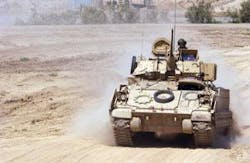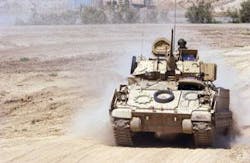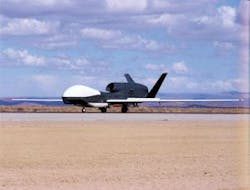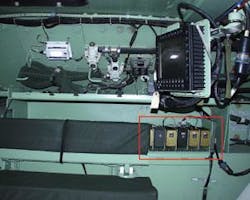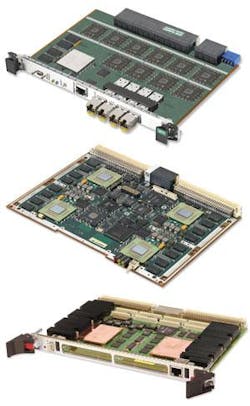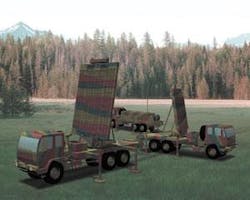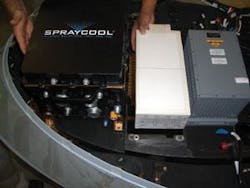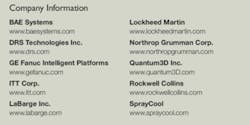A Voracious Need for Vetronics
Technology companies endeavor to bring advanced vetronics to the battlefield.
By Courtney E. Howard
Military end users have an increasing demand for computing and networking performance in packages that are ever smaller, lighter, and more power efficient, acknowledges Joe Baddeley, executive vice president of sales and marketing at SprayCool in Liberty Lake, Wa. This is especially true of electronics in military vehicles—land, sea, air, and unmanned vehicles alike—in which space is at a minimum and size, weight, and power (SWaP) restrictions prevail. Combat vehicles have not generally grown in size over the years—much the opposite, in fact—and yet, the number of electronic payloads within them has increased significantly.
“The network-centric battlefield of the future will continue to drive us in that direction,” Baddeley continues. Indeed, added electronics bring greater capabilities and functionality, but they are not without unwanted side effects, such as increased power requirements and greater thermal dissipation. More plentiful and more powerful electronics systems in smaller spaces increase the need for thermal management—a fact that virtually any sweltering warfighter inside a combat vehicle traversing the Middle Eastern desert can verify.
Chilling out
“Cooling is, of course, a continuing challenge as increasing amounts of computing horsepower are being shoe-horned into smaller spaces,” says David Compston, director of military and aerospace product marketing at GE Fanuc Intelligent Platforms in Towcester, England.
Potential solutions to this thermal challenge include developing electronics that throw off less heat, and implementing advanced thermal-management technologies and techniques. GE Fanuc officials have adopted both methods. On the one hand, the company has unveiled its VG6 single-board computer featuring the 8640 and 8640D processors, which dissipate 25 percent less heat than the 8641 and 8641D, yet deliver comparable processing performance. “For even more rigorous cooling requirements, more advanced cooling techniques are required—such as those provided by companies like SprayCool, with whom GE Fanuc has signed an agreement,” Compston describes.
GE Fanuc executives signed a global agreement with SprayCool to source the SprayCool Multi-Platform Enclosure (MPE), lending to integrated subsystems that include GE Fanuc’s commercial off-the-shelf (COTS) embedded computing solutions for military applications and advanced thermal management.
The SprayCool enclosures enable GE Fanuc to deploy high-performance computing electronics in harsh environments, as well as to offer customers a mix of boards with various ruggedization levels within the same platform, saving space and weight, says a representative.
SprayCool enclosures are designed to provide the box-level system designer with the flexibility to integrate a mix of proprietary air-cooled cards, legacy cards, conduction-cooled cards, and high-performance VPX cards in the same enclosure. This support for a wide range of electronics can shorten the deployment schedule, putting the necessary equipment in the hands of warfighters quickly.
“We are well known for our ability to provide demanding customers with powerful, reliable embedded computing subsystems capable of operating in the harshest environments,” says Peter Cavill, general manager of military and aerospace business at GE Fanuc, “and this agreement with SprayCool extends our capabilities even further, allowing us to propose very-high-performance solutions that would previously not have been possible.”
MEADS
A significant example of the changing nature of vetronics, and the rapidly growing requirement for more processing capability, can be found in the Medium Extended Air Defense System (MEADS) program, says Compston.
MEADS is commonly described as “a transatlantic cooperative effort between the United States, Germany, and Italy to develop an air and missile defense system that is tactically mobile and transportable.” MEADS is intended not only to replace Patriot systems in the U.S. and Germany, and the Nike Hercules system in Italy, but also to protect ground forces and fixed installations against current and next-generation airborne threats, including aircraft, missiles, and unmanned air vehicles.
Officials in Lockheed Martin’s Radar Systems business in Syracuse, N.Y., responsible for the truck-mounted surveillance radar for the MEADS program, have selected SprayCool and GE Fanuc technologies for integration in the system.
“Lockheed Martin Radar Systems selected GE Fanuc’s DSP220 VXS Quad 8641-based multicomputer and CRX800 Serial RapidIO switch for the heart of this system,” Compston describes. The CRX800 SRIO switch can support up to 18 payload cards, such as the DSP220, in one chassis.
Lockheed Martin engineers also opted to cool electronics in the radar platform with SprayCool technology. “SprayCool technology enables MEADS to efficiently operate COTS, as well as high-end, electronics densely packed on a mobile radar platform,” says Matt Gerber, president and chief executive officer of SprayCool.
“Operation of electronics in stressed, battlefield environments that are beset with extreme temperatures and airborne contamination requires a thermal-management solution that supports heating and cooling within a sealed electronics enclosure,” Gerber continues. “SprayCool’s technology does exactly that. SprayCool technology on the MEADS program will enable COTS performance improvements while simultaneously supporting the goals of lighter and smaller electronics.”
The MEADS platform is targeting five SprayCool enclosures containing 18 boards each, describes Eric Ballew, director of product management at SprayCool. “The MEADS system requirements are an example of the trend toward sensor processing required for situational-awareness applications.”
Compston agrees, noting that MEADS “is an excellent example of the growing importance of the capture and processing of sensor data as more information of higher quality is sensor-acquired and subsequently processed into a form that can be acted on.”
Data-driven demand
An ever-increasing amount of information is being collected, processed, analyzed, and shared in the field, as the U.S. Department of Defense (DOD) endeavors toward a true network-centric battlefield. This growing amount of mission-critical data is driving the need for vetronics in the field, on manned and unmanned vehicles alike.
The drive toward processing of sensor or image data at the collection source will continue and will, in turn, drive more demand for computing performance in harsh environments, Ballew predicts. “Whether it be on a UAV [unmanned aerial vehicle] application like Predator, radar system like MEADS, or command-and-control on-the-move in a CPP [command post platform] application, the need to process more data at the platform before transmitting the data over bandwidth-limited network links to command-and-control centers is a must.”
Officials at Northrop Grumman Corp. in McLean, Va., have selected SprayCool electronics enclosures for the U.S. Air Force RQ-4 Global Hawk and MQ-1B Predator unmanned aerial systems (UAS). Both contracts support the Airborne Signals Intelligence Payload (ASIP) program. ASIP is a signals intelligence sensor payload developed by the Electromagnetic Systems Laboratory in Northrop Grumman’s Mission Systems sector.
“SprayCool enclosures allow Northrop Grumman the flexibility to select from a wide range of electronics, some of which feature commercial-grade components, and field them in harsh environments like the high-altitude operation of the Global Hawk,” says SprayCool’s Gerber. “They are able to do that in un-pressurized, un-conditioned air space, leaving the more valuable, but limited conditioned air space available for legacy avionics.”
The SprayCool enclosures will house signals-intelligence electronics for the Air Force’s SIGINT-equipped MQ-1B Predator, in support of Predator’s tactical warfighting role, sometimes described as a hunter/killer/scout mission, describes Ballew. “This is a great example of the cross-platform migration of our MPE enabling capability from the U-2 manned aircraft to the Global Hawk UAV, to the Predator UAV platform,” he says, “primarily due to the fact the we provide the Northrop Grumman team the flexibility to deploy the ASIP electronics payload in unpressurized (non-ECS conditioned) spaces. In the case of unmanned platforms such as the MQ-1 Predator and Global Hawk UAVs, using SprayCool enclosures is the only alternative for unpressurized environments, where there is limited or no dedicated ECS [environmental control system] capacity.”
Data delivery and display
Data transmission, regardless of the amount of processing that occurs at the collection source, is integral to secure information-sharing in the field and is a serious concern today. The challenge is being met with technology from LaBarge Inc. in St. Louis. LaBarge engineers, under a $2.7 million contract from prime contractor BAE Systems Inc. in Rockville, Md., are producing the Ethernet switch unit for U.S. Army M2A3 Bradley Fighting Vehicles.
The Bradley A3 is a technologically advanced, mobile, digital fighting system that fulfills critical infantry, cavalry, fire support, battle command, and engineer roles for the Army’s heavy brigades. The armored personnel carrier is armed with heavy machine guns and TOW (tube-launched, optically-tracked, wire-guided) anti-tank missiles. The Bradley A3 communications system delivers digital information to the combat vehicle’s commander, driver, and squad leader.
“The Ethernet switches route and switch electronic data to the Bradley’s vetronics subsystems over the armored combat vehicle’s local area network,” says a LaBarge representative. Production on this contract is set to begin in December and continue through September 2009 at the company’s Huntsville, Ark., facility.
When the data reaches its destination, warfighters access the information via a digital display. In the case of manned ground vehicles in the U.S. Army’s Future Combat Systems (FCS) program, vetronics designers at BAE Systems contracted Rockwell Collins in Cedar Rapids, Iowa, to deliver the Common Crew Station Display. This rugged, 17-inch diagonal, high-resolution, flat-panel monitor will display maps, video, and other information, and will serve as the primary information monitor for the family of combat vehicles fielded as part of FCS.
“These displays will provide soldiers with enhanced situational awareness that will increase safety and effectiveness,” says Bruce King, vice president and general manager of surface solutions at Rockwell Collins.
Clear sight in combat
Whereas officials at BAE Systems and Rockwell Collins are outfitting FCS vehicles with capable displays, engineers at DRS Technologies Inc. in Parsippany, N.J., are expanding the warfighter’s line of sight from within many of today’s fielded combat vehicles.
DRS won a $116.6 million contract from Raytheon Company’s Network Centric Systems business in McKinney, Texas, to provide Horizontal Technology Integration Second-Generation Forward-Looking Infrared (HTI SGF) sighting systems and components for U.S. Army combat and tactical-wheeled vehicles. The systems will provide critical common night-vision technology to soldiers aboard the Abrams Main Battle Tank, Bradley Fighting Vehicles, and High-Mobility Multi-Wheeled Vehicles (HMMWV).
DRS’s high-resolution HTI SGF sighting systems are designed to help soldiers in ground vehicles detect, identify, and engage tactical enemy targets, day and night. The technology contributes to information dominance by providing soldiers with digital battlefield imagery, promoting interoperability among military platforms, says a representative.
Work on this contract will be performed at the DRS Sensors & Targeting Systems—Optronics Division in Palm Bay and Melbourne, Fla., and will be finished by July 2010.
“In fulfilling this contract, we will be providing tools that are essential to safeguarding American troops,” says James M. Baird, president of DRS’s reconnaissance, surveillance, and target acquisition (RSTA) business segment. The RSTA segment, which operates the Optronics division, develops, manufactures, and supports electro-optical technologies, including advanced cooled and uncooled thermal-imaging solutions for soldier systems, ground vehicle, airborne, maritime, industrial, security, public safety, and firefighting applications.
Combat vetronics
After a threat is detected, warfighters in the field elicit the help of advanced vetronics to avoid or neutralize that threat with electronic warfare technologies.
Officers at the U.S. Naval Sea Systems Command contracted engineers at ITT Corp. in White Plains, N.Y., to build and deliver its CREW 2.1 Vehicle Receiver Jammers (CVRJs), vehicle-mounted systems designed to prevent the detonation of improvised explosive devices (IEDs). These counter-IED devices are being mounted on various armored vehicles, and other military transport equipment, and deployed to current military operations in Iraq and Afghanistan.
The CVRJ program is helping the Department of Defense meet urgent system requirements and increased production demands to prevent the detonation of radio-controlled IEDs, says a representative.
Under the contract, worth up to $1 billion, ITT engineers are delivering up to 15,000 CREW 2.1 devices, in addition to spares and related equipment. Work is being performed at ITT’s Electronic Systems facility in Thousand Oaks, Calif.
Overcoming SWaP restrictions
Industry pundits agree that, when it comes to vetronics and the associated SWaP restrictions, a few options exist for systems designers and integrators: make systems smaller or make them do more, or both.
“Size and weight will always be significant constraints,” Compston recognizes, “and as military end users look to incorporate more and more advanced capabilities within a vehicle, each individual subsystem needs to be either smaller and lighter than its predecessor, or needs to be combined with other subsystems to create multifunctional subsystems.”
The most exciting technology in this area is 3U VPX, says Compston. “It allows significant computing power to be delivered by single-board computers that are small and lightweight—in a way that was not achievable with VMEbus or CompactPCI. We have seen significant interest in our 3U VPX products largely for these size- and weight constrained vetronics applications.”
GE Fanuc’s team also introduced the Rugged Operational Computer, which weighs less than six pounds, measures less than 100 cubic inches, and fits well into the tight spaces typical of military vehicle applications.
At the same time, vetronics serving several purposes in one system is desirable in the cramped quarters of combat vehicles. An example of this approach is embedded training, which enables warfighters to make productive use of what would otherwise be down time, says Compston. “An embedded training system leverages many of the capabilities that are already onboard the vehicle, such as screens and graphics processors, but allows them to be used for alternative applications,” he explains.
Compston notes an increasing demand for 3D image generation that leverages graphics technology originally designed for gaming. “The requirement in both applications is similar, in that images and situations must be presented with the maximum possible realism, delivering an immersive experience which is as close as possible to ‘being there,’” he says. “This kind of graphics capability is especially critical in embedded training situations.” In response, GE Fanuc engineers have introduced the company’s MAGIC1 Rugged Display Computer, which features graphics silicon from Nvidia Corp., a leader in PC gaming graphics technology located in Santa Clara, Calif.
Another interesting development is the Distributed Aperture System (DAS), Compston explains. “GE Fanuc has demonstrated a prototype of a system which sees video cameras mounted on each of the four ‘corners’ of a vehicle. Advanced processing allows the data from these cameras to be merged within the vehicle to form what appears to be a complete 360-degree view, which can be panned and scanned, providing situational awareness for the vehicle’s occupants in a closed-hatch situation.”
Wearable electronics
Executives and engineers at Quantum3D, maker of real-time visual simulation and computing systems in San Jose, Calif., understand that size, weight, and power are especially large concerns for military end users, especially in airborne and ground vehicle applications. In response, they are building space-saving, embedded systems with a soldier-worn component.
In one such system, the Quantum3D Thermite TVC-2.0 M3520, a tactical visual computer designed specifically for vehicle mounting, outputs maps and other information to the helmet-mounted cueing system worn by pilots flying the AV-8B Harrier jump jet. “The cool thing about having a graphical computer to do this is that it can be used for other functions, such as embedded training,” says Leslee Schneider, director of embedded visual systems at Quantum3D.
Transferring video data from UAVs, UGVs (unmanned ground vehicles), and manned units, including the soldiers themselves, to the vehicles, is an important element, Schneider continues. “These video streams can be transferred and shared among a group of individuals or a fleet of vehicles. Along with IData [Quantum3D’s human-machine interface tool] or other display capability, it provides a next-generation capability for network-centric warfare.”
Imminent advancements
For those working in the field of military vetronics, the future holds little mystery. It is a no-brainer, in essence: vetronics will be smaller, lighter, faster, and more powerful. They have to be.
“The future of electronics in the battlefield is the same as the future of electronics everywhere else,” Schneider says, “except they must be sturdier, tougher, faster, bulletproof, and have a longer life cycle.
“A bit more interesting from our perspective is that the embedded computer’s role has begun to change,” continues Schneider. “It used to be that military applications looked at computers as processors; but with improved capability, the demand for expanded video and graphics capability is skyrocketing. Graphics are in essence driving the next generation of applications on the battlefield—distributing video between several sources, providing 3D mapping solutions that can be leveraged across a group, and so on. It’s not just graphics/visuals, but also the interconnected nature of the data, enabling people in different locations to coordinate using the same information.”
“We are seeing a trend in which imminent obsolescence of a vetronics capability is being taken as an opportunity to substantially upgrade that capability not only with additional computing horsepower, but also with additional functionality,” reveals Compston. “Previously, imminent obsolescence more often meant that the approach was ‘let’s make sure we retain what we’ve got.’ Much development in vetronics will continue in a linear fashion from where we are today—more data being processed by more powerful, smaller, and lighter computers that require cooling.”
null
